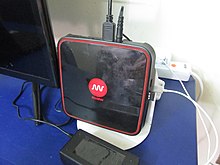This article has multiple issues. Please help improve it or discuss these issues on the talk page. (Learn how and when to remove these messages)
|

Internet Protocol television (IPTV), also called TV over broadband,[1][2] is the service delivery of television over Internet Protocol (IP) networks. Usually sold and run by a telecom provider, it consists of broadcast live television that is streamed over the Internet (multicast) — in contrast to delivery through traditional terrestrial, satellite, and cable transmission formats — as well as video on demand services for watching or replaying content (unicast).[3]
IPTV broadcasts started gaining usage during the 2000s alongside the rising use of broadband-based internet connections.[2] It is often provided bundled with internet access services by ISPs to subscribers and runs in a closed network.[4] IPTV normally requires the use of a set-top box, which receives the encoded television content in the MPEG transport stream via IP multicast, and converts the packets to be watched on a TV set or other kind of display.[3] It is distinct from over-the-top (OTT) services, which are based on a direct one-to-one transmission mechanism.
IPTV methods have been standardised by organisations such as ETSI.[5][6] IPTV has found success in some regions: for example in Western Europe in 2015, pay IPTV users overtook pay satellite TV users.[7] IPTV is also used for media delivery around corporate and private networks.[citation needed]
- ^ Jackson, Mark (22 August 2021). "Sky UK Allegedly Trial Broadband TV Service Without Satellite UPDATE". ISPreview UK. Retrieved 1 July 2024.
- ^ a b Ferguson, Andrew (November 2005). "IPTV the new buzz word in the UK broadband industry". Think Broadband.
- ^ a b Sharma, Ashok. "What is IPTV". Engineers Garage. Retrieved 1 July 2024.
- ^ Moro-Visconti, Roberto (17 April 2021). Startup Valuation: From Strategic Business Planning to Digital Networking. Springer. ISBN 9783030716080.
- ^ "Login Page" (PDF).
- ^ "Japan standardisation for IPTV services". 26 June 2008. Retrieved 1 July 2024.
- ^ "IPTV overtakes pay satellite TV in Western Europe". Broadband TV News. 12 April 2016. Retrieved 1 July 2024.